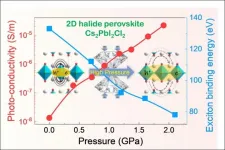(Press-News.org) Lithium-ion battery fire hazards are extensive worldwide and such failure can have a severe implication for both smartphones and electric cars, says the head of the group and Professor in the Department of Electrochemistry at St Petersburg University Oleg Levin. 'From 2012 to 2018, 25,000 cases of catching fire by a wide range of devices in the USA only were reported. Earlier, from 1999 to 2012, only 1,013 cases were reported. The number of fire incidents is increasing as is the number of the batteries being used,' he said.
Among the main reasons why lithium ion batteries catch fire or explode are overcharging, short circuit, and others. As a result, the battery is overheated and the battery cell goes into thermal runaway. Increasing the temperature up to 70 or 90°C can lead to hazardous chemical reactions that may result in further increasing temperature and consequently fire or explosion. To keep batteries from catching fire we can use an adjacent device, i.e. an electronic microcircuit. It tracks all parameters of the battery and can switch the battery off in case of emergency. Yet most of the fire incidents were due to failures of the electronic microcircuits caused by manufacturing defects.
'This is why it was particularly important to develop a safety strategy of the battery based on the chemical reactions to block the flow of electric current inside the battery pack. To this end, we propose to use a special polymer. Its electrical conductivity can adjust to the voltage fluctuations in the battery. If the battery works normally, the polymer does not prevent the electric current from flowing. If the battery is overcharged, there is a short circuit, or battery voltage drops below normal operating levels, the polymer goes into a so called isolator, circuit breaker, mode,' said Professor Levin.
There are polymers that can change resistance when heated, says Professor Levin. The problem we faced when using this technology, including in the companies in St Petersburg, was if the polymer starts working as an isolator, it means that the battery has been already undergoing overheating which has resulted in hazardous processes that cannot be stopped by merely breaking electric circuit. This makes this technology far from being effective. Yet such advances generated interests in searching new technologies, including the polymer that will be able to adjust voltage before the battery starts to overheat.
'I collaborated with Evegenii Beletskii, my postgraduate student at the Department of Electrochemistry, who had worked in industry. He has an extensive experience in developing battery safety systems. This helped us a lot in carrying out the experimental part of the project that focused on how the polymer worked. Anna Fedorova, a postgraduate student at the Department of Electrochemistry, also worked in industry. In the project, she was mainly concerned with calculating physical and chemical properties of the material,' said Oleg Levin.
The project lasted two years. During the six years before the start of the project to develop the technology, the scientists had carried out fundamental research to study the physical and chemical properties of a wide range of polymers. They discovered a class of polymers that change resistance with voltage. This was what the scientists got focused on.
'The most difficult part in developing the "chemical fuse" was to find an active polymer. We knew a great variety of polymers of this class. Yet choosing the one that would be suitable to create a prototype was a hard nut to crack,' said Oleg Levin. 'Moreover, we had to advance the technology by developing an industrial version to show that we had come up with an idea of effective battery safety strategy. Thus, we had to purchase a lot of new equipment for prototyping and adjusting techniques to work with lithium-ion batteries.'
What makes this safety technology different is high scalability. For example, how big the traditional adjusting guard circuit depends on how powerful the battery is. Therefore, the scheme of the motive power batteries of electric cars will be both big and costly. Scaling the 'chemical fuse' is simple as it is applied all over the surface of the inner current collector.
'Lithium-ion batteries use different type of cathodes, i.e. positively charged electrode by which electrons enter an electrical device. They have different working voltage. Thus, a safety polymer should react accordingly. We have managed to find a polymer that would be suitable for only one type of battery, that is a lithium iron phosphate battery. Changing the structure of the polymer might result in changing its conductivity to make it suitable for other types of cathodes that are on the market today. We have some thoughts as to how to make this safety strategy more universal by adding a safety component into the polymer to adjust to changes in temperature levels in the battery. This is expected to eliminate all fire risks associated with the batteries,' said Oleg Levin.
Before publishing the article, St Petersburg University received a patent for this technology. The scientists are currently preparing a real-size model of protected batteries to demonstrate them to potential investors.
INFORMATION:
Semaglutide, an injectable medication taken once a week, offers a nonsurgical way to reduce weight and treat obesity. It could help the more than 70 million adults in the United States who struggle with this chronic condition, says Ildiko Lingvay, M.D., M.P.H., M.S.C.S., professor of internal medicine and population and data sciences at UTSW and lead author of the study, published today in The Lancet.
People with diabetes benefit greatly from weight loss, yet they have a much harder time losing weight compared with those without diabetes, Lingvay says. This ...
WEHI researchers have uncovered a process cells use to fight off infection and cancer that could pave the way for precision cancer immunotherapy treatment.
Through gaining a better understanding of how this process works, researchers hope to be able to determine a way of tailoring immunotherapy to better fight cancer.
Led by Dr Dawn Lin and Dr Shalin Naik and published in Nature Cell Biology, the research provides new insight into the way cells adapt to fight infection.
This research lays the foundation for future studies into the body's response to environmental stressors, such as injury, infection or cancer, at a single cell level.
At a glance
WEHI researchers have studied dendritic ...
HPSTAR scientists Dr. Songhao Guo and Dr. Xujie Lü report three orders of magnitude increase in the photoconductivity of Cs2PbI2Cl2 from its initial value, at the industrially achievable level of 2 GPa, using pressure regulation. Impressively, pressure regulating the 2D perovskite's excitonic features gains it 3D compound characteristics without diminishing its own advantages, making it a more promising material for photovoltaic and photodetector applications. Their study is published as a Cover article in the latest issue of the Journal of the American Chemical Society.
Two-dimensional (2D) halide perovskites have recently emerged for photovoltaic and optoelectronic ...
In a report summary released today Thomas McAndrew, a computational scientist and assistant professor at Lehigh University's College of Health includes probabilistic forecasts of the impact of vaccines and variants on the U.S. COVID trajectory over the next few weeks. The goal of the report, says McAndrew, is "to support public health officials, infectious disease modeling groups, and the general public"
Report highlights:
A consensus of 91 forecasters predicts that the B.1.1.7. variant will be found in 42% of all genetic sequences with an S-gene mutation in the first two weeks of March and in 72% in all sequences between ...
Researchers have captured the first detailed images of newborn babies' lungs as they take their first breaths.
The research, led by the Murdoch Children's Research Institute (MCRI) and published the American Journal of Respiratory and Critical Care Medicine, provides a breakthrough in understanding the events around a baby's first breath, why healthy babies cry at birth and provides clues to improving preterm babies' survival chances and long term health outcomes.
About 10 per cent of newborns, and almost all preterm infants, need resuscitation because their lungs do not properly fill with air at birth (a process called lung aeration). Despite ...
New research from UBC finds that higher life satisfaction is associated with better physical, psychological and behavioural health.
The research, published recently in The Milbank Quarterly, found that higher life satisfaction is linked to 21 positive health and well-being outcomes including:
a 26 per cent reduced risk of mortality
a 46 per cent reduced risk of depression
a 25 per cent reduced risk of physical functioning limitations
a 12 per cent reduced risk of chronic pain
a 14 per cent reduced risk of sleep problem onset
an eight per cent higher likelihood of frequent physical activity
better psychological well-being on ...
If you've ever swatted a mosquito away from your face, only to have it return again (and again and again), you know that insects can be remarkably acrobatic and resilient in flight. Those traits help them navigate the aerial world, with all of its wind gusts, obstacles, and general uncertainty. Such traits are also hard to build into flying robots, but MIT Assistant Professor Kevin Yufeng Chen has built a system that approaches insects' agility.
Chen, a member of the Department of Electrical Engineering and Computer Science and the Research Laboratory of Electronics, has developed insect-sized drones with unprecedented dexterity and resilience. The aerial robots ...
Green tea supplements modulate facial development of children with Down syndrome
A new study led by Belgian and Spanish researchers published in Scientific Reports adds evidence about the potential benefits of green tea extracts in Down syndrome. The researchers observed that the intake of green tea extracts can reduce facial dysmorphology in children with Down syndrome when taken during the first three years of life. Additional experimental research in mice confirmed the positive effects at low doses. However, they also found that high doses of the extract can disrupt facial and bone development. More research is needed to fully understand the effects of green tea extracts and therefore they should ...
Imagine a robot.
Perhaps you've just conjured a machine with a rigid, metallic exterior. While robots armored with hard exoskeletons are common, they're not always ideal. Soft-bodied robots, inspired by fish or other squishy creatures, might better adapt to changing environments and work more safely with people.
Roboticists generally have to decide whether to design a hard- or soft-bodied robot for a particular task. But that tradeoff may no longer be necessary.
Working with computer simulations, MIT researchers have developed a concept for a soft-bodied robot that can turn rigid on demand. The approach could enable a new generation of robots that combine the strength and precision of rigid robots with the fluidity and safety of ...
The models used to produce global climate scenarios may overestimate the energy and emission savings from improved energy efficiency, warns new research led by academics at the University of Sussex Business School and the University of Leeds.
In a review of 33 studies, the researchers find that economy wide rebound effects may erode around half of the energy and emission savings from improved energy efficiency.
These rebound effects result from individuals and businesses responding to the benefits of improved energy efficiency - such as cheaper heating, lighting and travel. These responses improve quality-of-life, raise productivity and boost industrial competitiveness, ...






